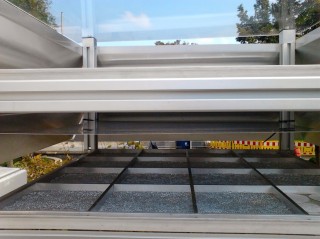Aug 18 2015
In a first-of-its-kind study, researchers have determined that natural sunlight triggers the release of smog-forming nitrogen oxide compounds from the grime that typically coats buildings, statues and other outdoor surfaces in urban areas.
 A study using glass beads to collect grime (above) shows that compounds can recycle from grime back into the air and contribute to pollution. Credit:Alyson Baergen
A study using glass beads to collect grime (above) shows that compounds can recycle from grime back into the air and contribute to pollution. Credit:Alyson Baergen
The finding confirms previous laboratory work using simulated sunlight and upends the long-held notion that nitrates in urban grime are “locked” in place.
The scientists will present their findings based on field studies conducted in Leipzig, Germany, and Toronto, Canada, at the 250th National Meeting & Exposition of the American Chemical Society (ACS), the world’s largest scientific society. The meeting features more than 9,000 reports and is being held here through Thursday.
“The current understanding of urban air pollution does not include the recycling of nitrogen oxides and potentially other compounds from building surfaces,” says James Donaldson, Ph.D. “But based on our field studies in a real-world environment, this is happening. We don’t know yet to what extent this is occurring, but it may be quite a significant, and unaccounted for, contributor to air pollution in cities.”
Urban grime, according to Donaldson, is a mixture of thousands of chemical compounds spewed into the air by automobiles, factories and a host of other sources. Among these compounds are nitrogen oxides. When in the air, these compounds may combine with other air pollutants — known as volatile organic compounds — to produce ozone, which is the main component of smog. But scientists had long suspected that nitrogen oxides become inactive when they are trapped in grime and settle on a surface.
However, Donaldson and his colleagues at the University of Toronto have collected data that are inconsistent with this theory. In previous work, they discovered that nitrate anions disappeared from grime at faster rates than could be explained by wash-off due to rainfall. And, in a subsequent laboratory comparison, they found that nitrate disappeared from grime 10,000 times faster than from a water-based solution when both were exposed to artificial sunlight. In yet another study, they exposed grime to either artificial sunlight or kept it in the dark. The grime exposed to a “solar simulator” shed more nitrates than the grime left in the dark, suggesting that light can chemically convert nitrogen compounds back into active forms that can return to the atmosphere.
Intrigued, Donaldson set out to test this concept in the real world. Working with colleagues in Germany, he set up a six-week field study in Leipzig and a similar year-long study in Toronto. The researchers placed grime collectors containing glass beads throughout both cities. The beads create more surface area for grime to gather on than a flat surface, such as a window.
Some of the collection devices were left in the sun; others were intentionally put in the shade, but had adequate air flow so that grime could collect on their surfaces. The Toronto study is ongoing and the data are still being analyzed. But in Leipzig, the researchers found that grime in shaded areas contained 10 percent more nitrates than grime exposed to natural sunlight, which was consistent with the team’s laboratory findings.
“If our suspicions are correct, it means that the current understanding of urban air pollution is missing a big chunk of information,” Donaldson says. “In our work, we are showing that there is the potential for significant recycling of nitrogen oxides into the atmosphere from grime, which could give rise to greater ozone creation.”
Interestingly, Donaldson notes that Leipzig has far more grime than Toronto, based on the amount of material gathered at collection stations in both cities so far. This difference could have a significant influence on the city’s air quality. “The fact that Leipzig appears to have 20 times more grime than Toronto suggests that there is a potential for 20 times more recycling of nitrogen oxides into the local atmosphere,” Donaldson says.
To test this idea, his team hopes to conduct field experiments in someplace that is “really grubby” and someplace that is “really clean.” They also plan to examine the effects of humidity, grime levels and various amounts of illumination on the recycling of nitrates back into the atmosphere